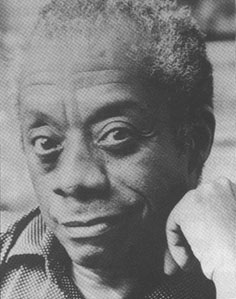PREVIOUS ISSUES | WEB LINKS PAGE | READER'S COMMENTS | BACK TO FLAME ARCHIVE HOME |INDEX OF ISSUES 1-10
PREVIOUS ISSUES | WEB LINKS PAGE | READER'S COMMENTS | BACK TO FLAME ARCHIVE HOME |INDEX OF ISSUES 1-10
Co-editors: Seán Mac Mathúna • John Heathcote
Consulting editor: Themistocles Hoetis
Field Correspondent: Allen Houglande-mail: thefantompowa@fantompowa.org
|

The Amen Corner belongs to a trio of works with an identical theme which James Baldwin wrote in the early 1950s. Its companions are the novel Go Tell It on the Mountain (1954) and the essay 'Notes of a Native Son.' In each, the background is provided by a Harlem family with a close involvement in the local pentecostal church, of a type which still dots the streets of uptown New York today. The church in The Amen Corner is unnamed, but it could be the Little Widow's Mite Church, on Lenox Avenue, or the Church of the Holy Agony, in a tenement round the corner; or the hand-painted sign outside the door could say the Temple of the Fire Baptised, which is the name given to the church in Go Tell It on the Mountain, in which the 'fire and excitement' of the singing and the beating tambourines caused the church to 'rock'. Likewise, in Baldwin's 'trilogy', the hero is always a boy who is wrestling with his faith - not to confirm the Lord's embrace, but to free himself from it; to step out, as Luke says in the play, "into the world". This is very much Baldwin's own story. He grew up in the church - he was, he liked to say, "born in the church". His father was a preacher in storefront churches like the one we see here, and, at the age of thirteen, Baldwin appeared to be about to follow him. He had a stark vision of good and evil - both the good and evil in the universe, and the good and evil on his Harlem doorstep - and a dramatic verbal gift. The combination must have made him an extraordinary boy preacher ("I was little", Baldwin would say, "but I was loud!"); it certainly helped, in the years to come, to make him a great writer. But here was the problem, the moral problem for which his church offered no guidance. If he was to preach, to continue as 'young brother Baldwin', to become an elder, a 'saint', possibly to head a church of his own, he could not write. For to write was to doubt. Even as a teenager, far from publication, he had begun to understand that the Harlem churches, fortresses for the saved, were also shelters for the helpless, the hypocritical, and the merely frightened. The exceptionally perceptive young minister's own religious crisis occurred when he admitted to himself that he too was using the church as a shelter. To survive in the dire streets of postwar Harlem, you had to have a gimmick, and his gimmick, he realised, was the church. This is the dilemma faced by more than one character in The Amen Corner. Like most plays, this one went through a number of transformations before finally settling into the shapely form we see here. When he began, Baldwin had in mind the pastor of his own church, Mother Horn, as a model for Sister Margaret, while the role of Luke was specially written for the Paris-based actor, Gordon Heath (he never got to play it). The first act made an appearance in print, in markedly different form, in the Paris magazine Zero in 1954, and in May of the following year the play was staged for an audience of students at Howard University, Washington DC. The director was Owen Dodson, and he left an amusing, if exasperated, account of how Baldwin and his current boyfriend, having come for two weeks, and lodging with the director, tried to stay for six months. "I don't care if you are going to be the greatest writer in the world", the fastidious Dodson told his notoriously irregular and sociable guest, "Get out!" After lying dormant for almost a decade, The Amen Corner was revived for a Broadway production in 1964 (Blues for Mr Charlie, Baldwin's second play, had opened at a theatre up the road). Later the same year, an entirely different production, directed by Lloyd Richards, toured Europe. By then, Baldwin was a celebrated author, and he followed his play to Berlin, Paris and Jerusalem, giving parties, greeting equally famous friends. But the theme - the meaning of salvation - never lost its urgency for him, just as the storefront church on the slum street corner, rocking and rolling, never lost its visceral excitement: There is no music like that music, no drama like the drama of the saints rejoicing, the sinners moaning, the tambourines racing, and all those voices coming together and crying holy unto the Lord. James Campbell is the author of Talking at the Gates: A Life of James Baldwin 1991. |
|
PREVIOUS ISSUES | WEB LINKS PAGE | READER'S COMMENTS | BACK TO FLAME ARCHIVE HOME |INDEX OF ISSUES 1-10 |
|